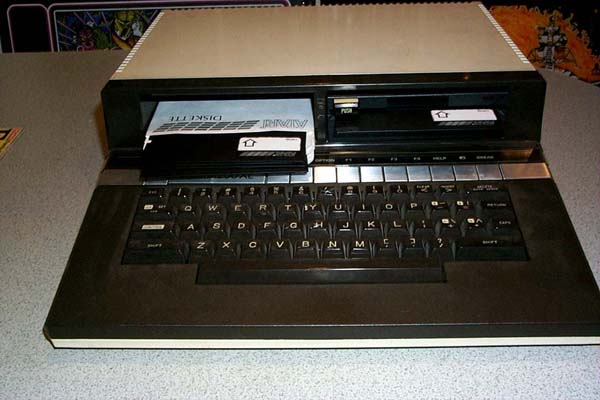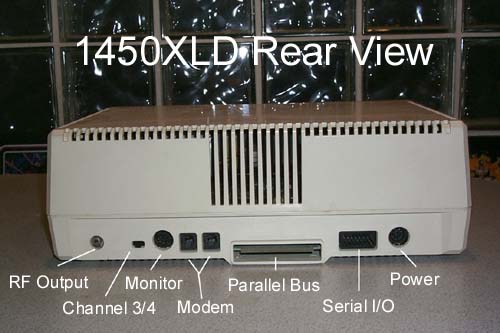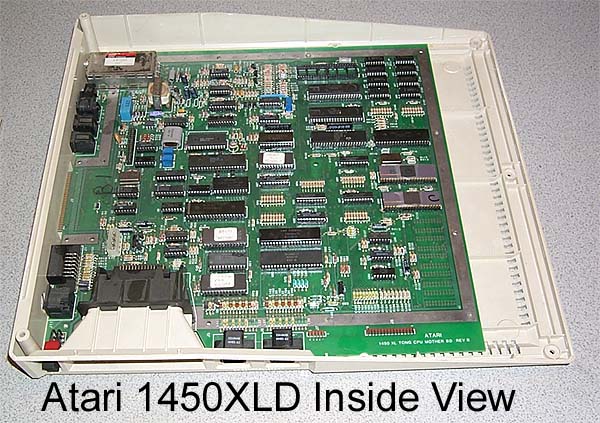
Atari
Engineering Notes
on
the 1450XLD project
(Adobe PDF Format)
![]()

Atari
Engineering Notes
on
the 1450XLD project
(Adobe PDF Format)
![]()
Not to put a damper on such a fine product, the 1450XLD may not have had a newer 16bit CPU or faster clock speed. What it did have was a new addition to the Atari chipset (which comprised the ANTIC, GTIA, POKEY and PIA). The new chip was called "FREDDIE" and what this little chip could have done was something that was sorely needed. Freddie was an MMU (Memory Management Unit), this new chip would have allowed BOTH the CPU and the ANTIC chip to independantly access different areas of memory for their own use. What did this mean for the user? It meant that a 1450XLD with a 1090XL expansion box containing one or more of the 64K memory modules would allow the CPU to access memory for programs (up to 64K) and the ANTIC could access up to 8K or more if needed to display graphics. This meant that programmers would have more freedom and flexibility in writing programs that could have had more complex commands, better graphics and enough memory to accomplish what they had in mind.

The next enhancement of the 1450XLD was its built in 300 baud modem. Atari from the start saw that computers would one day all be tied to central information systems and to each other and thought that it was important to include a modem in its computers. (Unfortunately Atari never included software that could upload and download until Atari Corp released SX-Express).
The 1450XLD also had a built in voice synthesiser to allow the user to write speech easily into their programs, by using the V: handler, users to have their programs speak, adding a new dimension to interactive computer use.
The final enhancement of the 1450XLD was it parallel disk drive controller interface and the inclusion of a 360K double density disk drive (a 2nd drive could be added at an authorized Atari service center) The parallel disk interface is much faster then the SIO interface of all the other Atari computers and would allow for up to 100K per second data transfers. However the disk interface proved to be unreliable and difficult to design and expensive since it required a PAL (Programmable Array Logic) which acted almost like a CPU itelf. This was because the disk drive could only deliver data at slow speeds and the disk drive itself was only spinning at 300 RPM.
Disk Controller ROM's
Hard drives spin at 3600 RPM and faster, most hard drives have a data buffer built into their onboard controller, disk drives do not so the parallel bus interface would look for the next piece of data from the disk drive, the disk could not access the data quick enough and the process would time out. Atari had to use a controller based on the National Semiconductor 8750 to control the flow of data to and from the disk drive to keep time outs from failing, this was an expensive solution.

The final Atari 1450XLD motherboards were known as the "TONG" motherboard and were HUGE and contained an onboard disk drive controller as well as a prototyping area and several ROM sockets which are rumored to have been either for foreign language sets for the voice synthesiser or for Apple ][e emulation ROMs. No one has ever been able to confirm or deny these rumors. The original 1450XL's were whats called the short board 1450XL motherboard with NO disk drive controller onboard, it would instead be a daughter card which would be sold and installed at a later time at an authorized Atari service center. The 1450XLD's would be sold as 1450XL's and when the user wanted the disk drive upgrade, they would bring their Atari 1450XL to an Authorized Atari service center and have the disk controller and one or two disk drives installed. This would make the PC seem more expandable to the customer and would have generated high volumes of upgrades for service centers and Atari to cash in on.

The 1450XLD is a beautiful
machine with an ominously powerful look and feel. Its disk
drives are fast and although in todays world, the modem is useless, its
nice to know the feature is there. The monotone robotic sounding
voice synthesizer is primitive by todays realistic true voice .WAV files,
but it too is a pleasant feature to have built in. The 1450XLD
is a machine all Atari users wish was released, however the project was
cancelled and so was its lower cost version: The Atari 800XLD which would
have been an Atari 800XL with Freddie Chip and a built in disk drive.
The speech an modem features would be dropped in favor of this new system
with a target price of $350. Also in the works were spec's
for yet another system designated the Atari 1650XLD, this information was
obtained from Steve Bristow and Ken Warren's Atari Engineering LogBooks.
The final system slated for release in 1st quarter 1985 was the 1850XLD,
according to Steve Bristow, this system would be based on the Amiga Lorraine
Specifications with detachable keyboard and 68000 processor.
Actual
Atari Engineering Log Sheet
on
1650XLD, 800XLD and 1850XLD.